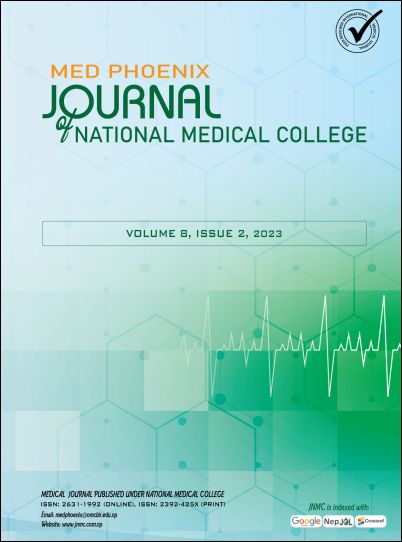Correlation of Glycated Hemoglobin with Serum Triglyceride to High Density Lipoprotein Ratio in Type 2 Diabetes Mellitus Patients
DOI:
https://doi.org/10.3126/medphoenix.v8i2.61815Keywords:
Diabetes mellitus, Glycated Hemoglobin, TG to HDL ratioAbstract
Introduction: Diabetes mellitus is an endocrine disorder characterized by hyperglycemia. It may be due to a defect in insulin secretion or action or both. Importantly, lipid metabolism is also abnormal in diabetes such as an increment of TG level and reduction in plasma HDL level which is the major cardiovascular risk. Glycated hemoglobin is measured to monitor the long-term glycemic status of the patients.
Materials and Methods: The current study is designed retrospectively to find out the correlation between HbA1C and TG to HDL ratio. The data onthe lipid profile of newly diagnosed diabetes mellitus were retrieved from the laboratory software of National Medical College, a tertiary care hospital in Madhesh province, Nepal. The categorical data were expressed in frequency and percentage and continuous data were expressed in mean and standard deviation depending on their distribution. Pearson correlation analysis was used to correlate the glycated hemoglobin and TG to HDL ratio.
Results: The current study investigated the diabetic and lipid profile in 604 retrospectively enrolled patients. Out of which 358 (59.3%) were diabetic and 246 (40.7%) were healthy subjects.The comparison of serum lipid levels between diabetes and healthy subjects revealed a significant difference concerningTriglycerides, total cholesterol, HDL, LDL, and VLDL (P value less than 0.05). The correlation analysis revealed a significant positive correlation betweenTG/HDL ratio and glycated hemoglobin (0.09, 0.02).
Conclusion: Our results revealed the correlation between HbA1C and TG/ HDL ratio in the Nepalese diabetic population. Hypertriglyceridemia was common in diabetic patients. Elevation of the TG/HDL ratio aggravates the cardiovascular risks in the diabetic patients.
Downloads
Downloads
Published
How to Cite
Issue
Section
License
Copyright (c) 2023 Med Phoenix

This work is licensed under a Creative Commons Attribution 4.0 International License.
Copyright on any research article is transferred in full to MED PHOENIX upon publication. The copyright transfer includes the right to reproduce and distribute the article in any form of reproduction (printing, electronic media or any other form).
© MEDPHOENIX
![]()
Articles in the MED PHOENIX are Open Access articles published under the Creative Commons CC BY License (https://creativecommons.org/licenses/by/4.0/). This license permits use, distribution and reproduction in any medium, provided the original work is properly cited.




